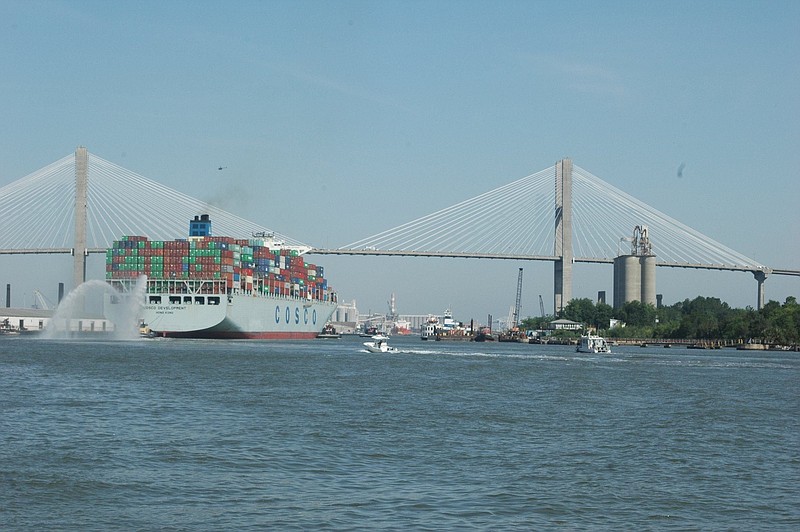SAVANNAH ― Trey Thompson's telephone rang very early Tuesday morning with a call from Georgia Ports Authority CEO Griff Lynch.
Both men had awokento the news that a cargo ship had struck a Maryland bridge near the Port of Baltimore overnight and caused the span to collapse, plunging several vehicles into the Patapsco River.
"Tell me what we do different," Lynch asked Thompson, the president of the Savannah Pilots Association, whose members guide cargo ships in and out of the Port of Savannah, including beneath the city's iconicTalmadge Bridge.
"We can't hit the bridge," Thompson replied before going on to explain how the Savannah bridge's supports sit outside the shipping channel. "We'd run aground long before something like that happened."
"I feel better," Lynch said.
The failure of Baltimore's Francis Scott Key Bridge prompted a flurry of calls among Georgia's port officials Tuesday morning. Ship traffic flows steadily to the Port Authority's two terminals in Savannah as well as sister facilities in Brunswick. Savannah's Garden City Terminal is the third-busiest cargo container port in the United States, routinely handling ships the size of the Dali, theSingapore-flagged vessel that hit Baltimore'sKey Bridge.
So does Brunswick, a popular destination for roll-on, roll-off (RORO) ships that transport automobiles and wheeled heavy equipment. Brunswick ranks No. 2, only behind Baltimore, in the shipping of vehicles on the East Coast.
The Key Bridge collapse brought back tragic memories of a similar incident near the Port of Brunswick more than 50 years ago. A cargo ship struck and partially collapsed the Sidney Lanier Bridge in 1972, resulting in 10 deaths.
The bridge was repaired and reopened only to be struck again 15 years later. No one was killed in the 1987 incident.
When a new Lanier bridge was built in 2003, the design included support pilings buffered by more than 2 acres of rock.
In Savannah, the state is raising the Talmadge bridge to help handle larger classes of cargo ships and is also exploring an ambitious plan to replace the bridge — either with a taller one, or potentially with a $2 billion tunnel.
"In the long term, it's important for people to know that we here at the ports authority clearly prefer the tunnel," Lynch said. "There are no obstructions that way. No depth or height restrictions."
Engineering isn't the only protections Georgia's current bridges have against vessel strikes. In Savannah, Thompson and his highly trained colleagues guide every ship along the 22-mile route between the ocean and the Ports Authority's terminals. Larger vessels are assisted by as many as three tug boats as they pass beneath the Talmadge Bridge.
"We're a river port and from a navigation standpoint, our pilots take great precautions in moving vessels," Lynch said Tuesday following a Georgia Port Authority board meeting. "I'm proud of our pilots and the great work they do."
Other incidents can happen, however. In 2019, the car carrier M/V Golden Ray caught fire and capsized just east of Brunswick's Lanier bridge, and it took about two years to fully remove the last pieces of the hulking ship.
The ship that hit Baltimore's Key Bridge, the Dali, reportedly lost power and issued a mayday prior to the collision. A propulsion failure results in a loss of steerage for the ship and leaves even the best pilots "along for the ride," Thompson said.
"That's where the tugs can really make a difference," he said.
At a Tuesday morning press conference, Maryland Gov. Wes Moore said the preliminary investigation affirms that the crash was not intentional. The Coast Guard and other first responders continued what was described as a search and rescue operation for the missing.
Officials also vowed to eventually rebuild the bridge, a vital thoroughfare for the Baltimore region.
State laws mandate most all the large cargo ships like the Dali that enter or exit aport host a local pilot whose knowledge of the channels, tidal flows and idiosyncrasies of the area is meant to keep its navigation safe.
"He doesn't replace the captain, but he directs the navigation," said Capt. Bruce Fendig, one of six Brunswick Harbor pilots who guide large vessels in and out of that busy harbor. While facts about the Key Bridge tragedy were still emerging and the cause was still under investigation, that system has worked to keep cargos and crews from harm in countless cases, he said.
"Every pilot serves a lengthy apprenticeship," he said. "There is three years training at a minimum and they make thousands of trips before they can get a license. And the Baltimore pilots are some of the finest, best-trained pilots in the nation."
Staff writer Michael E. Kanell contributed to this report.
